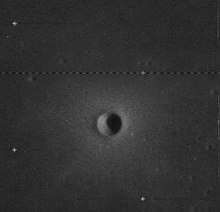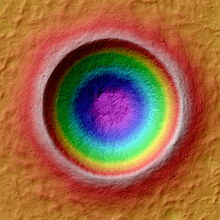Linné (crater)
Linné is a small lunar impact crater located in the western Mare Serenitatis. It was named after Swedish botanist Carl von Linné.[1] The mare around this feature is virtually devoid of other features of interest. The nearest named crater is Banting to the east-southeast. The estimated age of this copernican crater is only a few tens of millions of years. It was earlier believed to have a bowl shape, but data [2] from the LRO showed that it has a shape of a flattened, inverted cone. The crater is surrounded by a blanket of ejecta formed during the original impact. This ejecta has a relatively high albedo, making the feature appear bright.

 | |
| Coordinates | 27.7°N 11.8°E |
|---|---|
| Diameter | 2.4 km (1.5 miles) |
| Depth | 0.6 km (0.3 miles) |
| Colongitude | 348° at sunrise |
| Eponym | Carl von Linné |
In 1824 Wilhelm Lohrmann (1786-1840) of Dresden had drawn Linné as an 8 km diameter crater in his acclaimed lunar atlas, and in 1837 Wilhelm Beer and Johann Heinrich Mädler had described Linne in Der Mond as a 10 km crater.[3] In 1866, the experienced lunar observer and mapmaker Johann Friedrich Julius Schmidt made the surprising claim that Linné had changed its appearance. Instead of a normal, somewhat deep crater it had become a mere white patch. A controversy arose that continued for many decades. However, this crater size tests the limit of visual perception of Earth-based telescopes. In conditions of poor seeing this feature can appear to vanish from sight [4] (see also transient lunar phenomenon).

Satellite craters
By convention these features are identified on lunar maps by placing the letter on the side of the crater midpoint that is closest to Linné.
| Linné | Latitude | Longitude | Diameter |
|---|---|---|---|
| A | 28.9° N | 14.4° E | 4 km |
| B | 30.5° N | 14.2° E | 5 km |
| D | 28.7° N | 17.1° E | 5 km |
| F | 32.3° N | 13.9° E | 5 km |
| G | 35.9° N | 13.3° E | 5 km |
| H | 33.7° N | 13.8° E | 3 km |
The following craters have been renamed by the IAU.
- Linné E — See Banting (crater).
References
- "Linné (crater)". Gazetteer of Planetary Nomenclature. USGS Astrogeology Research Program.
- "Linne: Simple Lunar Mare crater geometry from LRO observations", 42nd Lunar and Planetary Science Conference (2011)
- David Leverington, Babylon to Voyager and Beyond: A History of Planetary Astronomy, Cambridge University Press, 2003
- "The Linne' crater controversey [sic]", The Lunascan Project
- Andersson, L. E.; Whitaker, E. A. (1982). NASA Catalogue of Lunar Nomenclature. NASA RP-1097.CS1 maint: ref=harv (link)
- Bussey, B.; Spudis, P. (2004). The Clementine Atlas of the Moon. New York: Cambridge University Press. ISBN 978-0-521-81528-4.CS1 maint: ref=harv (link)
- Cocks, Elijah E.; Cocks, Josiah C. (1995). Who's Who on the Moon: A Biographical Dictionary of Lunar Nomenclature. Tudor Publishers. ISBN 978-0-936389-27-1.CS1 maint: ref=harv (link)
- McDowell, Jonathan (July 15, 2007). "Lunar Nomenclature". Jonathan's Space Report. Retrieved 2007-10-24.CS1 maint: ref=harv (link)
- Menzel, D. H.; Minnaert, M.; Levin, B.; Dollfus, A.; Bell, B. (1971). "Report on Lunar Nomenclature by the Working Group of Commission 17 of the IAU". Space Science Reviews. 12 (2): 136–186. Bibcode:1971SSRv...12..136M. doi:10.1007/BF00171763.CS1 maint: ref=harv (link)
- Moore, Patrick (2001). On the Moon. Sterling Publishing Co. ISBN 978-0-304-35469-6.CS1 maint: ref=harv (link)
- Price, Fred W. (1988). The Moon Observer's Handbook. Cambridge University Press. ISBN 978-0-521-33500-3.CS1 maint: ref=harv (link)
- Rükl, Antonín (1990). Atlas of the Moon. Kalmbach Books. ISBN 978-0-913135-17-4.CS1 maint: ref=harv (link)
- Webb, Rev. T. W. (1962). Celestial Objects for Common Telescopes (6th revised ed.). Dover. ISBN 978-0-486-20917-3.CS1 maint: ref=harv (link)
- Whitaker, Ewen A. (1999). Mapping and Naming the Moon. Cambridge University Press. ISBN 978-0-521-62248-6.CS1 maint: ref=harv (link)
- Wlasuk, Peter T. (2000). Observing the Moon. Springer. ISBN 978-1-85233-193-1.CS1 maint: ref=harv (link)
External links
| Wikimedia Commons has media related to Linné (crater). |
- LTO-42A4 Linne — L&PI topographic map
- Wood, Chuck (December 12, 2004). "Swell Linné". Lunar Photo of the Day.